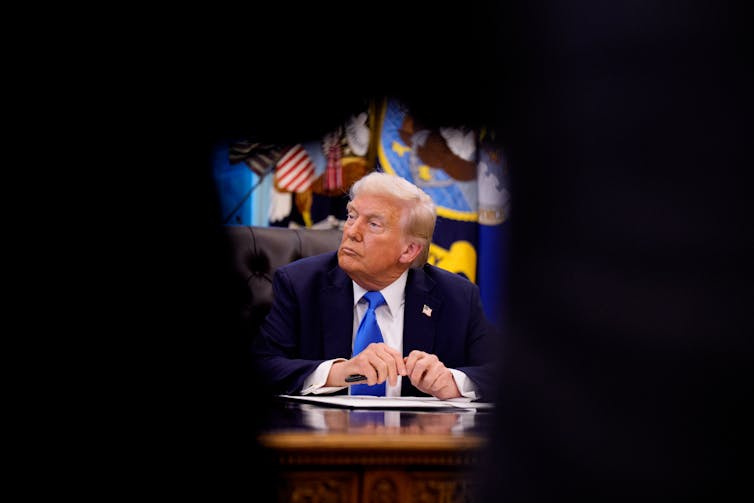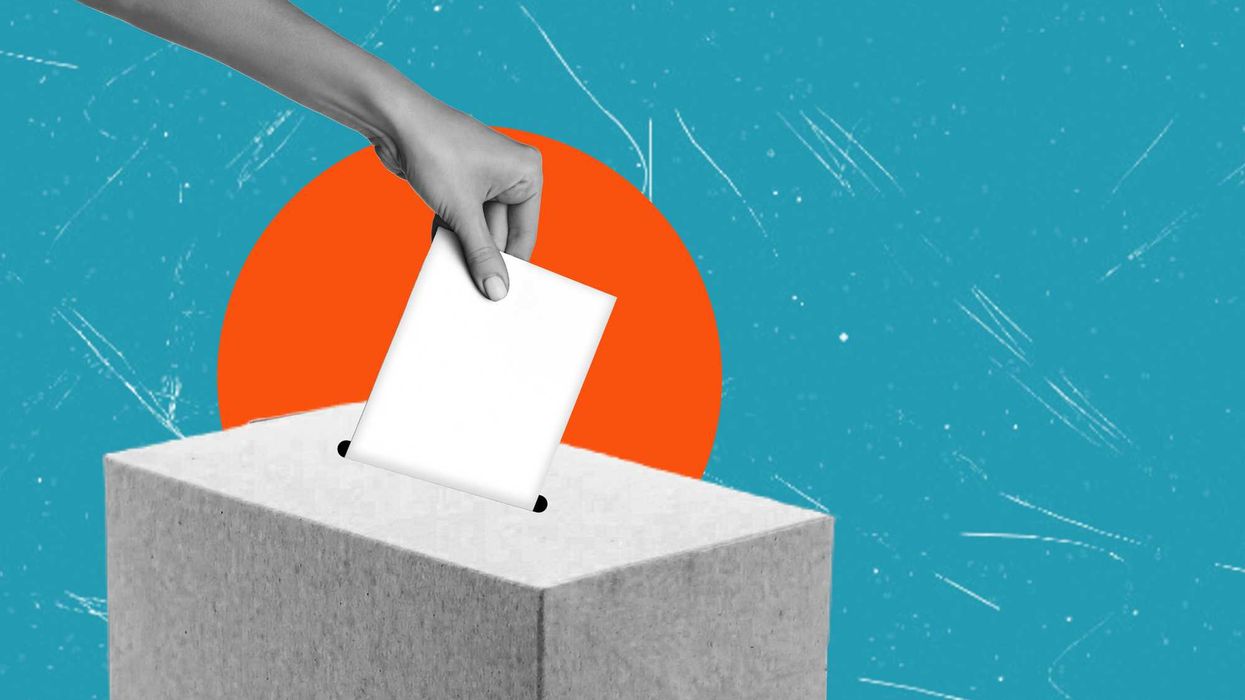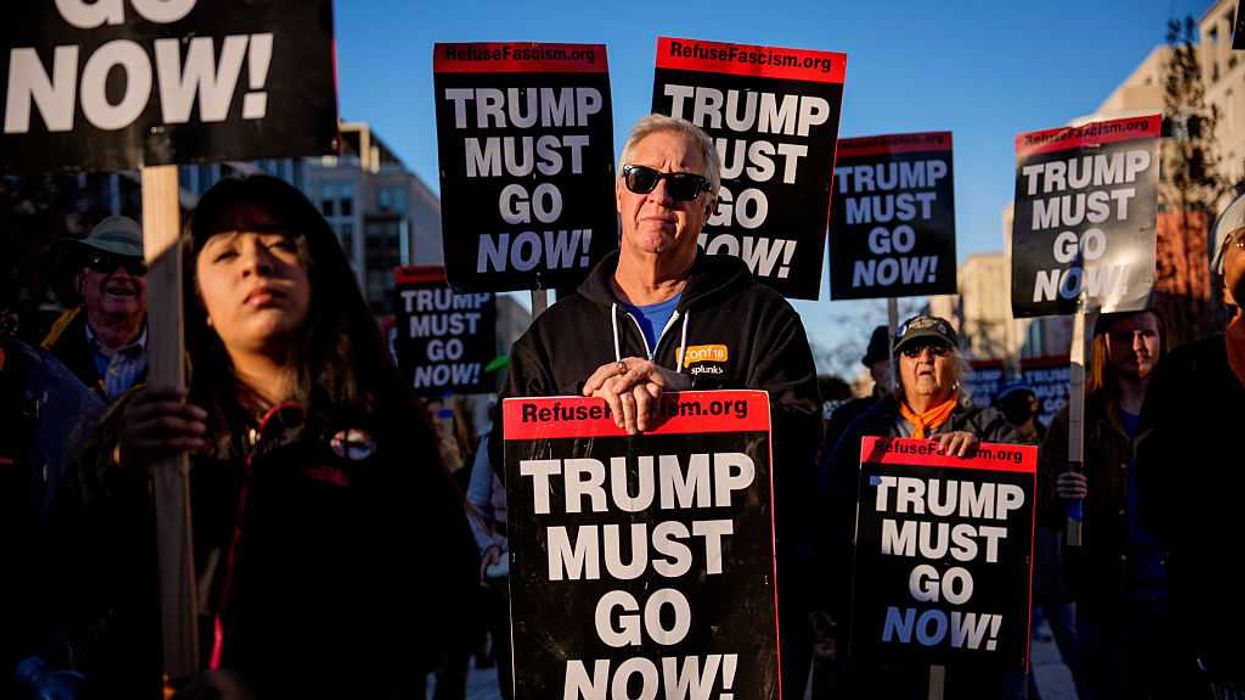The National Conference on Citizenship (NCoC) is dedicated to strengthening civic life in America. We pursue our mission through a nationwide network of partners involved in a cutting-edge civic health initiative, our cross-sector conferences and engagement with a broad spectrum of individuals and organizations interested in utilizing civic engagement principles and practices to enhance their work. Connecting people for the purpose of strengthening civic life is our goal. At the core of our joint efforts is the belief that every person has the ability to help their community and country thrive.
Site Navigation
Search
Latest Stories
Start your day right!
Get latest updates and insights delivered to your inbox.
Top Stories
Latest news
Read More

A new Trump administration policy threatens to undermine foundational American commitments to free speech and association.
Labeling Dissent As Terrorism: New US Domestic Terrorism Priorities Raise Constitutional Alarms
Dec 11, 2025
A largely overlooked directive issued by the Trump administration marks a major shift in U.S. counterterrorism policy, one that threatens bedrock free speech rights enshrined in the Bill of Rights.
National Security Presidential Memorandum/NSPM-7, issued on Sept. 25, 2025, is a presidential directive that for the first time appears to authorize preemptive law enforcement measures against Americans based not on whether they are planning to commit violence but for their political or ideological beliefs.
You’ve probably heard a lot about President Donald Trump’s many executive orders. But as an international relations scholar who has studied U.S. foreign policy decision-making and national security legislation, I recognize that presidents can take several types of executive actions without legislative involvement: executive orders, memoranda and proclamations.
This structure allows the president to direct law enforcement and national security agencies, with little opportunity for congressional oversight.
This seventh national security memorandum from the Trump White House pushes the limits of presidential authority by targeting individuals and groups as potential domestic terrorists based on their beliefs rather than their actions.
The memorandum represents a profound shift in U.S. counterterrorism policy, one that risks undermining foundational American commitments to free speech and association.
 The presidential memorandum signed by Donald Trump identifies ‘anti-Christian,’ ‘anti-capitalism’ or ‘anti-American’ views as potential indicators that a group or person will commit domestic terrorism. Andrew Harnik/Getty Images
The presidential memorandum signed by Donald Trump identifies ‘anti-Christian,’ ‘anti-capitalism’ or ‘anti-American’ views as potential indicators that a group or person will commit domestic terrorism. Andrew Harnik/Getty ImagesPresidential national security powers
Executive memoranda instruct government officials and agencies by delegating tasks and directing agency actions.
They can, for example, order a department to prepare reports, implement new policies, coordinate interagency efforts or review existing programs to align with the administration’s priorities.
Unlike executive orders, they are not required to be published. When these memoranda, like NSPM-7, relate to national security and military and foreign policy, they are called national security directives, although the specific name of these directives changes with each administration.
Many of these directives are classified. They may not be declassified, if at all, until years or decades after the end of the administration that issued them.
The stated purpose of NSPM-7 is to counter domestic terrorism and organized political violence, focusing mainly on perceived threats from the political left. The memorandum identifies “anti-Christian,” “anti-capitalism” or “anti-American” views as potential indicators that a group or person will commit domestic terrorism.
The memorandum claims that political violence originates with “anti-fascist” groups that hold the following views: “support for the overthrow of the United States Government; extremism on migration, race, and gender; and hostility towards those who hold traditional American views on family, religion, and morality.”
The strategy laid out in NSPM-7 includes preemptive measures to disrupt groups before they engage in violent political acts. For example, multiagency task forces are empowered to investigate potential federal crimes related to radicalization, as well as the funders of those potential crimes.
‘Domestic terrorist organizations’
The memorandum directs the Department of Justice to focus the resources of the FBI’s approximately 200 Joint Terrorism Task Forces on investigating “acts of recruiting or radicalizing persons” for the purpose of “political violence, terrorism, or conspiracy against rights; and the violent deprivation of any citizen’s rights.”
NSPM-7 also allows the attorney general to propose groups for designation as “domestic terrorist organizations.” That includes groups that engage in the following behaviors: “organized doxing campaigns, swatting, rioting, looting, trespass, assault, destruction of property, threats of violence, and civil disorder.”
Existing laws allow the secretary of state to designate groups as “foreign terrorist organizations” that are then subject to financial sanctions.
But these laws do not permit the president to label domestic groups this way.
 Would protesters like these at a Washington, D.C., ‘No Kings’ demonstration be seen as potential domestic terrorists by the Trump administration? Jose Luis Magana/AP
Would protesters like these at a Washington, D.C., ‘No Kings’ demonstration be seen as potential domestic terrorists by the Trump administration? Jose Luis Magana/APDefining terrorism
NSPM-7 marks a major conceptual shift in U.S. counterterrorism policy. Its focus on domestic terrorism significantly departs from historical approaches that primarily targeted foreign threats.
Earlier presidential directives largely defined terrorism as a foreign threat to be countered through military power, diplomacy and international cooperation.
Since Ronald Reagan’s presidency, the U.S. government had treated terrorism as a global menace to democratic institutions, emphasizing protection of citizens and allies abroad. By moving away from a traditional law enforcement framework and recasting terrorism as an act of war, the Reagan administration situated the issue within the broader realm of Cold War geopolitics and military advantage.
In the 1990s, the Clinton administration reframed terrorism as both a foreign policy and domestic security challenge, particularly after high-profile attacks such as the 1993 World Trade Center bombing and the 1995 Oklahoma City bombing. Clinton’s policy highlighted the dangers of transnational networks and the need to defend critical infrastructure.
After the 9/11 attacks, the Bush administration fused counterterrorism with national defense. The Bush-initiated global war on terrorism expanded the concept of who constituted a threat to include countries that harbored or aided terrorist organizations.
The Obama administration tried to narrow and regulate those powers by embedding counterterrorism within a system of legal rules and procedures. The key question, according to the declassified guidance, was whether the targeted individuals “pose a continuing, imminent threat to U.S. persons.”
This standard was not focused on ideology but rather on tactical considerations, such as the feasibility of capture and continued threat to U.S. interests.
For example, the lethal drone strike on al-Qaida propagandist Anwar al-Awlaki in 2011 was justified on the basis that he was actively involved in plotting attacks and remained unreachable for capture.
During the first Trump presidency, executive orders were used to change counterterrorism policy, most notably through several iterations of a “travel ban” that attempted to restrict immigration from terror-prone countries such as Iraq, Iran, Somalia, Syria and Yemen.
The Biden administration redirected attention toward preventing catastrophic threats, especially from weapons of mass destruction in the hands of groups or individuals outside of governments, such as terrorist organizations.
First Amendment rights at risk
There is no single official definition of terrorism in U.S. law.
Instead, laws use different definitions based on their purpose, whether criminal law or laws relating to intelligence collection or civil liability.
Definitions in all those areas typically focus on identifying violent or dangerous acts done with the intent to intimidate or coerce civilians or influence government policy.
But more than redefining terrorism, NSPM-7 reorients the machinery of national security toward the policing of belief.
The First Amendment generally prevents the government from punishing people for unpopular opinions. It also protects the ability for people to associate to advance public and private ideas in pursuit of political, economic, religious or cultural goals.
The directive’s emphasis on ideological orientations – “anti-Christianity,” “anti-capitalism” and “anti-American” views – as indicators of domestic terrorism potentially jeopardizes First Amendment rights.
Thirty-one members of Congress sent a letter to Trump expressing “serious concerns” about NSPM-7, warning that it poses “serious constitutional, statutory and civil liberties risks, especially if used to target political dissent, protest or ideological speech.”
As the ACLU warns, any definition of terrorism that includes ideological components risks criminalizing people or groups based on belief rather than based on violence or other criminal conduct.
Congress has declined to create a domestic complement to the foreign terrorist designation in large part because of the potential for impinging on First Amendment–protected association and speech.
But I fear that chilling speech may be the point.
Silencing dissent
NSPM-7 does not authorize new actions in the legal and institutional framework for counterterrorism. It does not criminalize previously legal conduct.
Rather, it states that the Trump administration’s investigative focus will be around the identity and ideology of supposed perpetrators. Prioritizing investigations into this broad swath of ideologies serves to instill fear, silencing anti-fascist and other messages in opposition to the Trump administration.
Law professor Steve Vladeck frames this chill as “obeying in advance,” in which organizations self-censor rather than risk investigation, prosecution or defending against the “domestic terrorist” label.
Although left-wing violence has risen in the past decade, empirical evidence proves that this violence remains at very low absolute levels, well below historical levels of right-wing or jihadist violence.
In fact, most domestic terrorists in the U.S. are politically on the right, and right-wing attacks account for the vast majority of fatalities from domestic terrorism.
Yet NSPM-7 focuses disproportionately on left-wing ideologies. NSPM-7 departs from prior U.S. counterterrorism frameworks by prioritizing the suppression of ideologically motivated dissent, even in the absence of concrete evidence of violent intent.
Labeling Dissent As Terrorism: New US Domestic Terrorism Priorities Raise Constitutional Alarms was originally published by The Conversation and is republished with permission.
Keep ReadingShow less
Recommended

President Donald Trump attends a Cabinet meeting at the White House on Dec. 2, 2025, in Washington, D.C.
(Chip Somodevilla/Getty Images/TCA)
This really may be the political end for Trump
Dec 11, 2025
Over years and years of covering politics, the last decade of which has been spent covering Donald Trump specifically, I’ve learned you can never really count him out.
It’s been a painful, exhausting, and deeply disappointing lesson, but an important one nonetheless. He keeps on keeping on. The things I find disturbing, revolting, and utterly disqualifying are inexplicably the same exact things that a not small number of Americans find appealing. Racism, incompetence, corruption, to name a few.
The things that would end any other politician’s career for good seem to have the opposite effect on his — instead of diminishing his power they only seem to embolden him. An impeachment, an insurrection, a criminal conviction, to name a few.
It’s been said many times, but the rules — of law, of political gravity, of general decency — just don’t seem to apply to him, and he’s taken extreme advantage of this phenomenon. And moreover, he seems to delight in his invincibility, flaunting the double standards and hypocrisy of one set of rules for him and another for everyone else, almost taunting his opponents to try getting away with what only he can.
So I almost never say what I’m about to say, because I’ve lived this exhausting reality for so long. But it feels like it’s finally true: this might just be the beginning of the end for Trump.
To be clear, this isn’t mere wishful thinking — though, for the good of the country I very much want to be rid of Trump and Trumpism once and for all.
It’s based on the inarguable reality of what we’re all witnessing — the walls are closing in on him.
Let’s take the polls to start.
A brutal new poll from Gallup has Trump’s approval in the gutter — he’s at -24%, down from -1% in January. Only Richard Nixon had a worse approval at this point in his second term, and he never recovered. Many other polls show similar, or even worse news for Trump’s standing among the electorate, where support from independents, Gen Z, and Hispanics has eroded significantly since his reelection. He’s even losing support among his base.
Then, there’s his economy. The signature pitch he made to voters was that he’d end inflation and make housing, energy, and consumer goods more affordable. Thanks to tariffs, DOGE cuts, profligate spending, and incompetence, Trump’s exploded the national debt and deficit, inflation has risen since January, unemployment is also up, consumers are seeing higher, not lower, prices at the grocery store, small businesses are seeing increased costs of operating, and more Americans believe Trump has been worse for the economy, not better.
Then there’s his personnel. Trump has been fending off serious issues of incompetence inside his administration since Day 1. His secretary of defense is being accused of war crimes. His head of the FBI is rumored to be on the chopping block. His attorney general is routinely mocked for her ineffectuality. Scientists from nearly every field of study have called for his head of health and human services to be replaced. His homeland security secretary may be prosecuted for contempt.
Then there’s his party. One-time staunch allies like Reps. Marjorie Taylor Greene and Nancy Mace are ignoring his threats and breaking with him on issues of America First, Jeffrey Epstein, and the shutdown. At least five Republicans have announced they are retiring or will not seek reelection. GOP senators ignored Trump’s urging to end the filibuster, and state lawmakers have rejected his redistricting efforts.
Finally, there are his media surrogates. Top MAGA influencers, who mainly reach Trump voters on Youtube and other platforms, are intentionally alienating the normies in the center-right by elevating neo-Nazis, excusing pedophilia, and engaging in some truly bizarre conspiracy theories.
But the biggest red flag that not all is well in Trump world? Trump himself. Monday night, Trump flooded Truth Social with more than 160 posts in five hours — an unhinged mix of high and low, from posting his cameo in “Home Alone 2” to demanding disgraced Colorado election official Tina Peters be released from prison.
It was a disturbing look at someone who’s clearly lost control — of his presidency, of his party, of his messaging. Flooding the zone with utter nonsense to distract us all from his obvious failures is seemingly all he has left.
Again, it’s never wise to declare Trump dead, politically. Somehow he always manages to slither back into a place of power and protection. But this time, with midterms around the corner, it feels different. This time, it feels like it might be the end.
S.E. Cupp is the host of "S.E. Cupp Unfiltered" on CNN.
Keep ReadingShow less

Personal stories from constituents can profoundly shape lawmakers’ decisions. This excerpt shows how citizen advocacy influences Congress and drives real policy change.
Getty Images, EyeEm Mobile GmbH
Want to Influence Government? Start With Your Story
Dec 10, 2025
[The following article is excerpted from "Citizen’s Handbook for Influencing Elected Officials."]
Rep. Nanette Barragán (D-California) wanted to make a firm statement in support of continued funding of the federal government’s Supplemental Nutritional Assistance Program (SNAP) during the recent government shutdown debate. But instead of making a speech on the floor of the U.S. House of Representatives, she traveled to the Wilmington neighborhood of her Los Angeles district to a YMCA that was distributing fresh food and vegetables to people in need. She posted stories on X and described, in very practical terms, the people she met, their family stories, and the importance of food assistance programs.
There is a cloud of cynicism that envelopes American politics, leading many to believe that their voice doesn’t make a difference. And, sure, on some politically charged issues, like guns or immigration, it is probably unlikely that one story will change a politician’s position. But on everything else (which is most of what Congress does), it is impossible to overstate the importance of constituents’ personal stories and the influence they have in the policy process.
During an interview with a member of Congress for a book I was writing on citizen engagement, I asked him to recount to me a difficult decision he made in the past and what were the factors that influenced his final decision. “Oh yes,” he said immediately. “The issue was federal funding for stem cell research,” which is quite controversial due to its connection to the abortion debate. He explained to me that he was genuinely torn on the issue and had not come to a final decision. Then, one day, he was visited by a teenager from his district. “Congressman, I have juvenile diabetes,” the young man said to the congressman, “and it is my hope that this research might someday lead to a cure for me and others like me.” The congressman leaned into me and said, “That meeting just stuck with me.” He explained how he did further research on the topic and eventually became a cosponsor of legislation to increase funding for the stem cell research … and he was a pro-life Republican.
Legislators trying to determine the best policy outcome can wrestle with facts and figures until they are blurry-eyed. And yet, when they come face-to-face with an actual person whom the policy affects, it completely focuses their thinking. They no longer see data and reports associated with that policy; they see a person. And no matter the legislator’s position on the issue—pro or con—she feels an obligation to the person: either to help him, or to adequately explain why she can’t. “The most effective way to influence a lawmaker is for a constituent to talk to a legislator about how the policy will affect the person or a particular group,” said one House Democrat.
If the story is powerful enough and demonstrates some societal injustice or ill, it can actually be translated into legislation. “Meagan’s Law” requires law enforcement authorities to make information regarding sexual offenders available to the public. It was enacted because of the powerful story of a little girl who was abducted, raped, and killed. There is now a popular trend of naming bills after victims, such as “Heather’s Law,” “Rachel’s Law,” “Haley’s Act,” and the Amber Alert system.
On the lighter side, a constituent told a congressman about an unpleasant experience he had at the doctor’s office. After being told to disrobe and put on a flimsy paper smock that didn’t close in the back, the man was asked to sign papers related to his care without fully understanding their meaning. He felt quite uncomfortable and disadvantaged in the setting—and told his congressman so. This led the legislator to introduce a bill, “The No Private Contracts to Be Negotiated When the Patient is Buck Naked Act.” Amusingly, this bill was introduced by Rep. Pete Stark (D-California), so it quickly became known as the “Stark Naked Act.” (It actually gained 18 cosponsors!)
One House Democrat, who was a member of the powerful House Appropriations Committee, had a memorable experience that demonstrates the value of personal stories. “I went to a luncheon that was hosted by cancer centers in my state,” he said. “Instead of having those guys in white coats doing their lobbying, they brought in patients—kids and their parents. They all got up and told their story. When it was done, there wasn’t a dry eye in the room. They gave us the human importance of those dollars we're being asked to appropriate. Every group needs to do that.”
By putting a face on an issue, the citizen-advocate makes the policy pitch real in a way that a lobbyist cannot. “I’ve seen my boss change his mind because of a personal story,” said one House chief of staff. When petitioning the government and meeting with a federal, state, or local lawmaker, the smart citizen-advocate will come to the meeting with the most powerful tool at their disposal: their story.
Bradford Fitch is the former CEO of the Congressional Management Foundation and author of “Citizens’ Handbook for Influencing Elected Officials.”
Keep ReadingShow less

Virginia Governor-elect Abigail Spanberger promises major reforms to the state’s felony disenfranchisement system.
Getty Images, beast01
Let's End Felony Disenfranchisement. Virginia May Lead the Way
Dec 10, 2025
When Virginia’s Governor-Elect, Abigail Spanberger, takes office next month, she will have the chance to make good on her promise to do something about her state’s outdated system of felony disenfranchisement. Virginia is one of just three states where only the governor has the power to restore voting rights to felons who have completed their prison terms.
It is the only state that also permanently strips a person’s rights to be a public notary or run for public office for a felony conviction unless the governor restores them.
Spanberger’s predecessor, Republican Glenn Youngkin, did everything in his power to make it very difficult for any felon to get their voting rights restored. During her campaign, Spanberger said that she would follow the examples of the governors of Iowa and Kentucky, who, as NPR reports, “Have signed orders to make the process automatic for most people with felony convictions.”
That is a step in the right direction, but it does not go far enough.
Executive action can be undone by Spanberger’s successor, just as Youngkin reversed the effort of his predecessor to ease the path for ex-felons to vote. Additionally, a pending federal lawsuit seeks to have the state’s felony disenfranchisement law invalidated for violating one of the provisions of the post-Civil War Virginia Readmission Act of 1870, which prohibited disenfranchising voters.
Beyond what Spanberger can do and whatever happens with the lawsuit, Virginia should amend its constitution to end felony disenfranchisement. That process is already underway, but in the meantime, efforts should be made to end the practice nationwide.
Doing so would require removing or circumventing a provision in the Fourteenth Amendment to the United States Constitution. That provision allows states to abridge voting rights "for participation in rebellion, or other crime."
In 1965, when Congress passed the Voting Rights Act, it enacted a nationwide ban on poll taxes or the use of literacy tests as voting qualifications. But it did nothing about felony disenfranchisement.
Some advocacy groups think that Congress could address this issue by enacting legislation, while others believe it would require a formal constitutional amendment. Whatever route is taken, the decision on whether felons should lose their right to vote should not be left to states like Virginia to decide.
Today, the voting rights of ex-felons depend on where they live. In Maine, Vermont, and the District of Columbia, felons can vote even while they are incarcerated. In 23 states, the voting rights of felons are automatically restored when they finish their prison terms.
In other states, felons lose their voting rights while on parole and/or probation, but these rights are restored once the parole and/or probation processes are completed. In addition, they may also have to pay outstanding fines, fees, or restitution before they can vote.
In still others, of which Virginia is one, felons may never be able to vote, depending on the crime they commit. Alternatively, they must obtain a pardon from the governor or go through some other process before their voting rights can be restored.
As of 2024, approximately four million people were barred from voting due to felony disenfranchisement laws, although this number may have decreased due to recent changes in those laws in a few states. The non-profit Sentencing Project reports that “nationally, one in 22 eligible Black voters is disenfranchised… a rate more than triple the rate of other voters.”
However, regardless of the number of people affected, denying the right to vote for any group is such a fundamental problem that it warrants a national response.
It will not be easy to do away with felony disenfranchisement, whose roots date back to the colonial period. In the post-Revolutionary period, from 1776 to 1821, 11 states adopted constitutions that allowed or required the practice, with Virginia being the first to do so.
In its first constitution, Virginia stripped the franchise from those who committed “infamous crimes” that reflected “moral turpitude.” Its 1851 constitution added bribery to that list. Seventeen years later, Virginia made a conviction of treason or corruption grounds for disenfranchisement.
Professor Jean Schroedel and her colleagues note that by the outbreak of the Civil War, Virginia had a lot of company in its enthusiastic embrace of felony disenfranchisement: “Three-quarters of states,” they say, “had criminal disenfranchisement statutes. These laws were based on ‘legal moralism’ principles, which limited the franchise to those in good standing in the community."
Felony disenfranchisement was so widespread that the people who drafted the Fourteenth Amendment took it for granted, even as they sought to dismantle other vestiges of slavery.
In Virginia, more than 300,000 Virginians are currently unable to vote due to their criminal record. As Brittany Amadi, one of the lawyers who brought the pending federal lawsuit, says, “In Virginia today, we [still] disenfranchise people for things like drug offenses…By disenfranchising all people with felony convictions, Virginia is breaking federal law and disproportionately excluding Black and brown people from the ballot box.”
That is one reason why Governor-elect Spanberger plans to take executive action to address felony disenfranchisement and why she supports amending the state constitution to end it altogether. If she does so, it will add momentum to efforts to enhance democracy by challenging felony disenfranchisement everywhere.Austin Sarat is the William Nelson Cromwell professor of jurisprudence and political science at Amherst College.
Keep ReadingShow less
Load More














